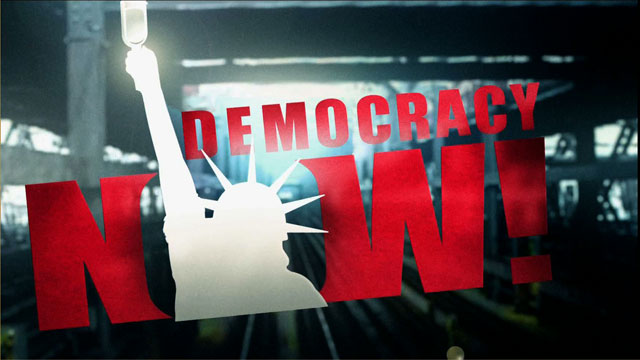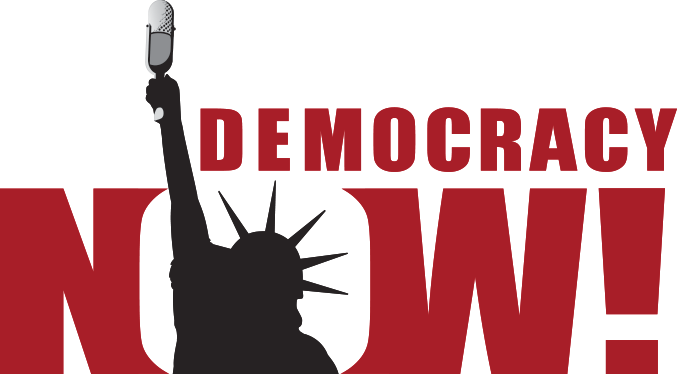
In a ceremony attended by several heads of state, but with the noted absence of President Clinton, the United States today initiates the handover of the Panama Canal after a century-long presence in Panama.
Clinton is apparently staying away from the ceremonies because he fears it would damage Vice President Al Gore’s presidential campaign, and former President Jimmy Carter will head the U.S. delegation at the event instead. Carter set the withdrawal in motion in 1977, when he signed treaties relinquishing U.S. control of the waterway by noon on December 31, 1999. The handover ceremonies are taking place two weeks early to avoid a conflict with millennial celebrations.
Built under President Theodore Roosevelt, the canal opened in August 1914 and cost thousands of lives to build, mostly of enslaved workers from the West Indies, who died of exhaustion, yellow fever and other illnesses.
Transcript
AMY GOODMAN: And you are listening to Pacifica Radio’s Democracy Now!, as we go to another issue outside of our borders, intimately connected to the United States. A ceremony is taking place now in Panama, attended by several heads of state, but with the noted absence of President Clinton. Some pundits speculate that he doesn’t want to be in Panama for the handover of the Panama Canal, because it could damage Vice President Al Gore’s campaign. But it has angered Panamanians that the only person who is in Panama, the only — the highest-level representative of the United States, is an acting under secretary of the State Department. This was noted yesterday in comments by the Panamanian foreign minister, José Miguel Alemán.
LAMOIN WERLEIN-JAÉN: With respect to the significance of the transfer of the Panama Canal and the completion of the Torrijos-Carter Treaties —
AMY GOODMAN: We’re going to go to an interview that I just did with a person in Panama City in just a minute. But we do want to go back to that comment of José Miguel Alemán, who was expressing a great deal of anger yesterday at the fact that not only President Clinton was not in Panama, but Madeleine Albright, who said she’d come, also canceled her visit there. This is the Panamanian foreign minister.
JOSÉ MIGUEL ALEMÁN: And the feeling I have gotten from the other members of the other countries is that they are disappointed and perplexed.
AMY GOODMAN: The foreign minister of Panama. Well, Jimmy Carter is there. The former president is leading the U.S. delegation. Carter set the withdrawal in motion of the United States from Panama in 1977 when he signed treaties relinquishing U.S. control of the waterway by noon on December 31st, 1999. The handover ceremonies today are taking place two weeks early to avoid a conflict with millennial celebrations.
Built under President Theodore Roosevelt, the Panama Canal opened in August of 1914 and cost thousands of lives to build, mostly of enslaved workers from the West Indies, who died of exhaustion, yellow fever and other illnesses.
Early this morning, I got a chance to speak with Panamanian journalist Lamoin Werlein-Jaén, who was getting on a bus to go to the diplomatic ceremonies today. And he spoke about the significance of the handover of the Panama Canal.
LAMOIN WERLEIN-JAÉN: With respect to the significance of the transfer of the Panama Canal and the completion of the Torrijos-Carter Treaties, we really can’t overstate the significance of these events for Panama.
In the first instance, it represents the culmination of a hundred-year struggle on the part of the people of Panama for sovereignty and self-determination, a struggle that, unfortunately, has, at various times in our history, propelled us into conflict with the United States. We remember very well down here that in 1925 the United States invaded Panama City to crush a general strike, killing six protesters and wounding dozens others. In 1964, protesting Panamanian students were attacked by U.S. forces, and in a three-day conflagration, over 22 Panamanians were killed and over 500 wounded by U.S. soldiers. And then, of course, in 1989, during the invasion, ostensibly to overthrow the government of General Manuel Antonio Noriega, over 2,000 innocent Panamanians were killed. So, these events that we’re seeing now is really the culmination of that struggle and is the vindication for all the people who lost their lives in that struggle.
In the second instance, it represents the first time in our nation’s history that the Panamanian state will actually control the entire national territory, and the achievement, finally, after 95 years of republican history of sovereignty. And finally, it represents an immense set of possibilities for Panama’s development, not only in the sense that we now control the canal and the areas around it, and we can now put those areas to Panama’s use of Panama’s development, but also as just a massive infusion of capital and infrastructure and real estate, that had been historically controlled by the United States and now is going to be in Panamanian hands. So, again, down here, we really feel that we cannot overstate the significance of these events, and it is truly being greeted in Panama as our second independence.
AMY GOODMAN: How did the U.S. get the canal?
LAMOIN WERLEIN-JAÉN: The United States gained control of the Canal Zone area in order to build the canal by way of a treaty with the newly independent Panamanian government in 1903. Historically in Panama, this is known as the treaty that no Panamanian signed, because a French engineer under the employment of the French Panama Canal Company, who was in Washington, D.C., during the period when Panama was separating from Colombia, he negotiated. He was empowered by the Panamanian government to establish contact with the U.S. government and begin to hammer out the terms of establishing diplomatic relations and so forth. This individual, one Philippe Bunau-Varilla, signed a treaty with the United States conceding territory in Panama to the United States to build the canal, but also to control that area as a colonial enclave. And then this treaty was later presented to the Panamanian government as a fait accompli, which, you know, newly having recently achieved independence and so forth, the Panamanian government was not in a position to protest or to do anything about this treaty.
AMY GOODMAN: Lamoin, I’ve reached you just before you get on the bus, the media bus, to cover today’s events. While you talk about the final handover being the end of the year, December 31st, can you explain what’s happening today?
LAMOIN WERLEIN-JAÉN: Today, they’re going to be celebrating the diplomatic ceremony for the transfer of the canal. So, we have foreign dignitaries arriving in the country. Former President Jimmy Carter arrived yesterday in Panama. So it’s going to be the official ceremony today for the transfer. The actual transfer of the canal is going to happen at 12 noon on December 31st, as stipulated by the Panama Canal Treaties. But with the certain preoccupations with the Y2K and so forth, and the millennium, it was decided that they would move up the diplomatic ceremonies.
AMY GOODMAN: I was just listening to the Panamanian foreign minister expressing dismay over the fact that the current Clinton administration has only sent an under secretary from the State Department. Madeleine Albright was supposed to go, but she canceled today.
LAMOIN WERLEIN-JAÉN: Correct. It’s really been received as an insult down here, the fact that the Clinton administration did not see fit to either send a high-level delegation, such as Albright, or for Clinton to come himself. It really, unfortunately, represents a lost opportunity for the United States to try to establish a new relationship with Panama. This would have been a golden opportunity for the United States to sum up its experience in Panama, to attempt to put a positive spin on it and to attempt to redefine a new relationship. Unfortunately, the U.S. government has squandered that opportunity, and once again, it’s left a bad taste in many people’s mouths around here.
AMY GOODMAN: Can you talk about what you mean by an infusion of capital?
LAMOIN WERLEIN-JAÉN: Well, the canal, there’s — the canal is being transferred to Panama, but along with it, there are 14 military — U.S. military bases that have also been transferred to Panama, as well as vast areas around the canal where the infrastructure which supported the canal is. This includes over 147 hectares — 147,000 hectares of land, including over 3,000 buildings, including housing stock, office buildings, hospitals and an airport, in fact, as well as power generation stations and things of this sort. So it really represents a massive infusion of infrastructure and capital into the country, which, in many respects, is a one-time deal that, you know, can only have a positive impact on the nation’s development.
AMY GOODMAN: The way it’s being played here in the newspapers is: Can the Panamanians deal with it? While there’s been resentment of the American presence, can the Panamanians themselves actually run the canal?
LAMOIN WERLEIN-JAÉN: That, unfortunately, is the spin that’s being put out in the United States, which, more than anything, reflects a certain chauvinism and arrogance on the part of the U.S. press and the U.S. political establishment. For the better part of the last decade, over 95% of the workforce of the canal has been Panamanian. Currently, 97% of the workforce is Panamanian. So the transfer of the canal is a jurisdictional change in its administration. The fact is, Panamanians have been running the canal for at least 10 years. It has been run with the same efficiency as it was run before. There have been no problems with the maintenance of the canal in these last 10 years. There have been no problems with upgrading and investments in the canal. There have been no problems in investments that the canal has made or in the finances of the canal. Everything has run fairly smooth for the last 10 years, during which time the canal has actually already been in Panamanian hands.
AMY GOODMAN: Lamoin Werlein-Jaén. He is a reporter with — he is an independent reporter who is down in Panama right now. He himself is Panamanian, though he does live in San Francisco. He was just getting on the bus, when I spoke with him early this morning, to go to the diplomatic ceremony where the United States is handing over the Panama Canal to Panama. The official moment that the canal gets handed over is December 31st at noon.
You are listening to Pacific Radio’s Democracy Now! When we come back, we go up in a tree in Northern California, and we’ll go to Minneapolis, as well, for struggles around forests. You’re listening to Democracy Now! We’ll be back in a minute.












Media Options